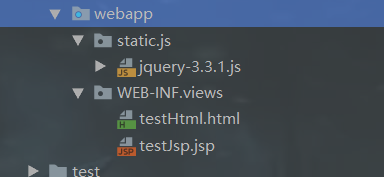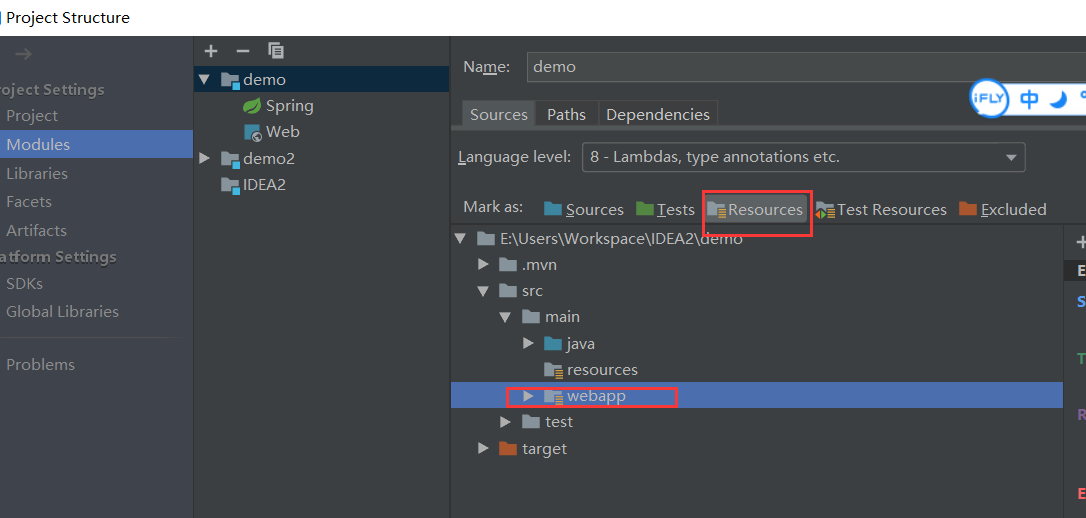Spring boot project creation tutorial https://blog.csdn.net/q18771811872/article/details/88126835
springboot 2.0 jump to html tutorial https://blog.csdn.net/q18771811872/article/details/88312862
jsp+html jump integration https://blog.csdn.net/q18771811872/article/details/88343672
This is a tutorial to jump to jsp page separately. I will introduce html and jsp coexisting later. I temporarily annotated the thmeleaf template and configuration
1 create directory results and jsp files

2. Configure the return return template and code
@RequestMapping(value = "/testJsp", produces = "application/json;charset=UTF-8", method = {RequestMethod.POST, RequestMethod.GET})
public String testJsp(Model m, HttpServletRequest request, HttpServletResponse response){
List<Map<String,Object>> list=userService.userQueryAll();
request.setAttribute("list",list);
log.info("Entered testJsp Method!");
return "views/testJsp";
}3.application.yml file configuration thmeleaf template parameter
spring:
dataSource:
type: com.alibaba.druid.pool.DruidDataSource
url: jdbc:mysql://localhost:3306/db-test?useUnicode=true&characterEncoding=utf8&tinyInt1isBit=false&usessl=false
username: root
password: 123456
driverClassName: com.mysql.jdbc.Driver
mvc:
view: #Available after new version 1.3
suffix: .jsp
prefix: /WEB-INF/
view: #Old version 1.4 abandoned
suffix: .jsp
prefix: /WEB-INF/4. Add tomcat and jsp support to pom.xml file. If there are temporary comments on the thmeleaf package, only jsp jump is written here (when there are thmeleaf packages, the return template will jump to html page first)
<!--tomcat Support-->
<dependency>
<groupId>org.springframework.boot</groupId>
<artifactId>spring-boot-starter-tomcat</artifactId>
<scope>provided</scope>
</dependency>
<dependency>
<groupId>org.apache.tomcat.embed</groupId>
<artifactId>tomcat-embed-jasper</artifactId>
<scope>provided</scope>
</dependency>
<!--servlet rely on.-->
<dependency>
<groupId>javax.servlet</groupId>
<artifactId>javax.servlet-api</artifactId>
<version>4.0.1</version>
<scope>provided</scope>
</dependency>
<!--jsp Tag library-->
<dependency>
<groupId>javax.servlet</groupId>
<artifactId>jstl</artifactId>
</dependency>
5. The JSP page uses the EL expression directly here
<%@ page contentType="text/html;charset=UTF-8" isELIgnored="false" pageEncoding="UTF-8" %>
<%@ taglib uri="http://java.sun.com/jstl/core_rt" prefix="c" %>
<%
String path = request.getContextPath();
String basePath = request.getScheme() + "://" + request.getServerName() + ":" + request.getServerPort() + path + "/";
%>
<!DOCTYPE html >
<html lang="zh-CN">
<head>
<title>Title</title>
<meta http-equiv="Content-Type" content="text/html; charset=utf-8"/>
<script src="<%=basePath%>static/js/jquery-3.3.1.js" charset="utf-8"></script>
</head>
<body>
<table border="1">
<thead>
<tr>
<th>Serial number</th>
<th>Name</th>
<th>number</th>
<th>Creation time</th>
</tr>
</thead>
<tbody>
<c:forEach items="${list}" var="listv" varStatus="status">
<tr>
<td>${listv.id}</td>
<td>${listv.name}</td>
<td>${listv.phone}</td>
<td>${listv.create_time}</td>
</tr>
</c:forEach>
</tbody>
</table>
</body>
<script type="text/javascript" charset="utf-8">
</script>
</html>
6. In project structure, this is usually configured by default. If not, add it

This is how it starts. The rendering is as follows

Original address https://blog.csdn.net/q18771811872/article/details/88342298
springboot 2.0 jump to html tutorial https://blog.csdn.net/q18771811872/article/details/88312862
jsp+html jump integration https://blog.csdn.net/q18771811872/article/details/88343672
Spring boot project creation tutorial https://blog.csdn.net/q18771811872/article/details/88126835